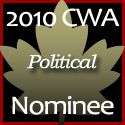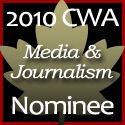
This is the second part of
a topic I'm delving into, relating to Stephen Harper's involvement with a group he helped found:
The Northern Foundation, and his Reform Party's pro-active stance against the end of Apartheid in South Africa.
Since the Conservative government has started targeting Kingston as a riding they really want, we have been introduced to some of the worst dregs the Reform Party had to offer, including Gerry Nicholls, who wrote a piece against Michael Ignatieff. Nicholls was VP of the
National Citizens Coalition when Harper was president, and is one of the biggest rednecks in Canada.
However, it was a column by Peter Worthingon that caused the most concern, but thanks to that article I could link the
National Citizens Coalition to the Nelson Mandela story, which means that Harper has scored the trifecta.
A bio of Mr. Worthington can be found at Wikipedia but I'm going to just give a few brief bits of it that are very important:
A conservative, Worthington led the brash new tabloid throughout the 1970s as it
campaigned against the government of Pierre Trudeau. At one point he was jailed after being
accused of violating the Official Secrets Act.
Worthington was criticized when it was revealed that he had informed to the American Federal Bureau of Investigation about the suspected political sympathies of a number of his friends including
June Callwood.
Worthington is the stepfather of conservative writer Danielle Crittenden (
She has been critical of the feminist movement and is considered to be a social conservative. Crittenden is the editor of The Women’s Quarterly magazine. She is married to former George W. Bush special assistant and speechwriter David Frum and resides in Washington DC.) and is thereby
David Frum's father-in-law.
David Frum is a close insider with Harper's party and in fact it was on his suggestion that Stockwell Day, then Alliance Party leader,
refused to send condolences to the Palestinian people on the death of President Yassir Arafat.
"In a November 16 email to his Conservative colleagues Mr. Day stated: "Some of you have asked why I have not released a statement of condolence or sympathy. As you know, there are two sides to the Arafat story. You pick...." He then included in the email an article by David Frum, former speech writer for George W. Bush, indulging in unfounded speculation about the cause of Arafat’s death. Frum suggested that Arafat’s symptoms “sounded AIDS-like.” Now we know where Harper got his "cut and run" speech that he delivered on his first official visit to Afghanistan. At the time I stated that 'Harper makes a great ventriloquist's dummy, but I think I saw G.W. lips move'. The speech was a condensed version of one given by Bush to the U.S. Naval Academy.
That's what we're going to be up against, though Abrams may regret exposing these people to Kingstonians, and aligning them with his party.
But back to Worthington. This relates to a story I found, written by John Saul, entitled: History Matters South African History. He goes into the story of Worthington and his involvement with the pro-Apartheid movement in the 1980's.
Mr. Saul can relate his story as a member of the anti-Apartheid movement taking place at the same time and through the two books I've been sharing; we can connect Stephen Harper, His Reform Party and his Northern Foundation.
Now for excerpts from:
Two Fronts of Anti-Apartheid Struggle: South Africa and Canada
History Matters
South African History
John Saul
May 13, 2009
I have been, for most of my adult life, a student of southern African, including South African, affairs, I was pleased but also intrigued to receive an invitation from Ingrid and the South African Association of Canadian Studies to come to SA to give several talks and seminars in this country (and also to “launch” my most recent book, Empire and Decolonization, as I will do at The Book Lounge on Thursday evening).
But let me also insert parenthetically, right at the outset, what amounts to a personal disclaimer of my own – before I proceed to the more important business of the collaboration between Canada and South Africa in support of apartheid as well as the much more savoury links between (many) Canadians and (most) South Africans in resistance to that system.
As you no doubt can surmise, my own roots are European too, albeit grounded in another country of English conquest, with my ancestors coming to Canada from Ireland in the 1850s ... the decisions of my ancestors to migrate to Canada rather than to South Africa are another of those might-have-beens of history – though in this case no doubt it is one that is of no interest to anybody but myself!
"... Where then, I asked myself back in Canada, should I enter into the topic evoked by my title: Two Fronts of Anti-Apartheid Struggle: South Africa and Canada?
To begin with, there are obvious parallels between the two countries, not least in the fact that both Canada and South Africa, as we know them, were targets and outcomes of Western European imperial conquest. True, the histories were somewhat different. In Canada, the indigenous societies, some agrarian-based and others premised on hunting, trapping and a more nomadic existence, were an easy target for something very close to quasi-genocide for much of our early history, and then an extreme form of marginalization more recently.
On the other hand, in South Africa, at least beyond the Cape, the large and more firmly settled and grounded indigenous African populations were less vulnerable to any such “final solution.” Instead, here, whites – when not killing blacks and driving them off the most economically promising land – became adept, as we know all too well, at availing themselves, to the advantage of the white-dominated economy, of the labour of such indigenes.
Not that there were no insights from these diverse processes of conquest and settlement to be shared. Quite the contrary. In fact, instructive parallels were readily grasped, on both continents, by the oppressors themselves, South African leaders, for example, turning eagerly to Canadian experience with “Indian reservations” for guidance in further crafting and firming up their “homeland” structures in the 1920s. (Remember in
the first part of this story I mentioned Reform Party member Norman Wallace:
"Wallace created considerable controversy in 1987 when he and others involved in a group called the Indian Business Development Association put up money for a South African tour for five Saskatchewan Indian leaders ... intended to give the Pretoria regime a public relations weapon - using aboriginal conditions in Canada to demonstrate the Canadian government's hypocrisy.")
As Ron Bourgeault, a leading writer on such themes, notes:
It is significant that South Africa came to Canada at different times since the Boer War asking and getting permission to study the Canadian system by which Indian people were controlled and managed separately from the politically dominant white population. South African took what it needed and applied it to its own situation: first to segregation, and after the Second World War to apartheid. The fundamental difference between Canada and South Africa was [as I have myself noted above: JSS] that Canada was interested in segregating and managing, as cheaply as possible, a population it did not want as an important source of labour. South Africa was interested in the same type of relationship, but for a people whose labour it needed and wanted cheaply.
"As Borgeault further observes, “South Africa turned to Canada in the first decade of the 20th century,” since “Canada was probably the only advanced capitalist state that had elaborate system of administration and territorial segregation of an internally colonized indigenous population, a possible exception being the United States.”
"Indeed, Canada’s Dominions Land Act of the 1870s (after which the South African Land Settlement Act of 1912 and 1913 was actually patterned, according to Bourgeault), and related acts including our very Indian Act, restricted Indians, as they were then termed (now “First Nations” people), from acquiring property or trading their goods off the reserves.
They also deprived Indians of the vote, and even established a kind of pass system for exit and re-entry to reserves. Small wonder that apartheid South Africa was interested.
"... No surprise, then, that as late as 1962 the South African ambassador to Canada, W. Dirkseven-Schalwyck, made an extensive tour of reserves in western Canada, meeting churches and visiting agency headquarters and educational and agricultural facilities. The ambassador studied the form of band government, the relationship of the central state apparatus of Indian Affairs to the bands, and social and economic problems encountered on the reserves. The ambassador’s interest was in how the Indians were maintained in their “homelands,” and how the central state related administratively to their maintenance.
"A second, related point bears noting here. For there were also some intriguing activities undertaken by an apartheid government that continued to play its own tune on the embarrassing parallels between the histories of the two countries. This was particularly notable during the deeply unpleasant Glenn Babb’s aggressive tour of duty as South Ambassador to Canada in the mid-1980s. (Further to Norman Wallace: "(Reform Party member) Wallace cultivated a friendship with South African ambassador Glen Baab and was instrumental in introducing him to other Saskatoon businessmen during a Baab tour to Saskatchewan in March 1987. (Preston Manning and the Reform Party. Author: Murray Dobbin Goodread Biographies/Formac Publishing 1992 ISBN: 0-88780-161-7, pg. 105)
"True, the bulk of native leadership in Canada – even as they pressed forward with their continuing claims and demands against the Canadian government – scorned this practice and made it clear, in Borgeault words, “that the Indian people of Canada [refused] not go down in history as allies of racist fascism.” But there was some kind of parallel nonetheless, and momentarily Babb made the most of it.
And, not surprisingly, he found support for such tricks and for the evil apartheid regime that sponsored them in Canada more widely: there was, in fact, a considerable network of backing for the combination of prejudice and profit that spawned a support for apartheid South Africa in Canada and hence a certain degree of organized pro-apartheid agitation existed, especially amongst the privileged classes.
"The crudely racist, flamboyantly anti-communist and vividly right-wing journalism of Peter Worthington was a particularly prominent feature of this for anyone living in Toronto during these years, but those of us in the Canadian anti-apartheid network at the time were well aware of its broader reach.
"For example, a well-researched 1988 article in the western Canadian journal Briarpatch listed a host of right-wing and business-related groups hard at work defending apartheid: the Western Canadian Society of South Africa and the extremely well-connected Canadian-South African Society, for example. Indeed the husband of Canada’s then Governor-General, Jeanne Sauve, was actually a member of the latter until shamed into resigning in 1985.
"But note carefully the operative phrase I used above: prejudice AND profit. (both relate to the ideology of the Reform Party)
By the latter years of the twentieth century the links forged between the Canadian and the apartheid establishments were not primarily based on shared racism in fact, or even on shared Cold War mantras but on the bald logic of mutual profit-seeking – although it was only last year that our current Prime Minister, Stephen Harper, saw fit to rise in Parliament in Ottawa and offer “an apology to the indigenous people in Canada for the injustices done to them for generations by successive Canadian governments” in the twentieth century. (Does Mr. Saul know of the connections between Stephen Harper's Northern Foundation and all of these groups involved in the pro-Apartheid movement?)
Moreover, just two weeks ago, Phil Fontaine, the National Chief of Canada’s Assembly of First Nations had an audience with Pope Benedict in the Vatican; there the Pope also apologized for the Church’s participation in various acts of cultural despoliation inflicted upon Native communities in Canada.
Nonetheless, in our own anti-apartheid support work our primary, indeed seemingly endless, preoccupation was with contemporary Canadian corporate links with South Africa.
"... The corporate response was, at best, stony silence (although there were also some attempts to infiltrate private spies into our ranks (Remember from part one of this story, regarding Donovan Carter: his operation fell apart when two of his recruits from Winnipeg, Geoff Shaw and Ihor Wichacz, became increasingly worried about the tasks they were assigned and went public ... they were asked to infiltrate anti-apartheid groups.... "))
"... Nonetheless, although support that indulged both in various euphemisms for racism and in uncritical cheer-leading for capitalism – together with judicious red-baiting – did grind on, it also began to become apparent, during the 1980s, that changes were afoot in the western governmental-cum-corporate sphere with respect to South Africa, including in Canada, changes of no small magnitude. Of course, the roots of a rethinking lay primarily here inside South Africa itself and in the continuing escalation of internal resistance here of the mid-80s. But, as we now know, there were also the meetings of business heavyweights with the ANC that were re-writing the ground rules of “common-sense” in South Africa.
In the final part of this story, I will show the links between Worthington, the Reform Party and Harper's Northern Foundation, and finally the National Citizens Coalition. It's been quite a journey.
 This is the second part of a topic I'm delving into, relating to Stephen Harper's involvement with a group he helped found: The Northern Foundation, and his Reform Party's pro-active stance against the end of Apartheid in South Africa.
This is the second part of a topic I'm delving into, relating to Stephen Harper's involvement with a group he helped found: The Northern Foundation, and his Reform Party's pro-active stance against the end of Apartheid in South Africa.


No comments:
Post a Comment